Among many other releases, ASUS has shown several upcoming peripheral releases at Gamescom, including both the ROG Harpe Ace Mini and the Harpe Ace Extreme, the latter of which had already been announced prior. Interestingly enough, the mouse demonstration units weren't pre-production units, but rather from mass production, hinting at an impending release. While no exact date has been revealed, both the ROG Harpe Ace Mini and the Harpe Ace Extreme indeed are expected to hit shelves within the next few weeks.
Shared between both mice are their basic specifications and internals. Much like on the ROG Keris II Ace, ASUS's latest AimPoint Pro sensor capable of 42,000 CPI sees use, along with ROG Optical main button switches. When asked for comment, ASUS has stated that on their enthusiast mouse releases, optical switches will continue to be preferred over push-fit mechanical switch sockets to save as much weight as possible. Through the ROG Polling Rate Booster, polling rates of up to 8000 Hz can be achieved in wired operation, and up to 4000 Hz in wireless operation. Since the firmware is shared across all models, performance of the ROG Harpe Ace Mini and the Harpe Ace Extreme will closely match the Keris II Ace provided the ROG Polling Rate Booster is used.

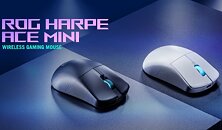
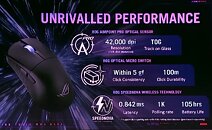
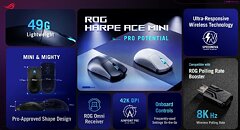
Those generally interested in ASUS mice but scared off by the prospect of having to deal with Armoury Crate will be pleased to hear that by the end of 2024, Armoury Crate will be reworked to become modular. In other words, one will be able to only install the parts actually desired, reducing both the installation size and RAM footprint in the process. In a way, it will be possible to tailor one's own Armoury Crate Gear.
ASUS ROG Harpe Ace Extreme
At 47 g, the Extreme weighs 7 g less than the regular Harpe Ace, which, depending on how one looks at it, could be considered a success or a disappointment. In any case, one has to keep in mind that the shell typically only accounts for roughly a third of the total weight, which is why the ability to save weight in this area is limited, and ASUS has valued structural integrity over achieving the lowest possible weight. Whereas the shell of the regular Harpe Ace has been made of bio-based nylon, the Extreme comes with a fully CNC-machined carbon fiber shell. No comment has been made which modulus is used, and the numbers provided by ASUS are inconclusive in this regard, too. Regardless of modulus, carbon fiber will surpass any other material used in gaming mice thus far in terms of stiffness-to-weight ratio and, more specifically, its tensile strength. On the other hand, carbon fiber tends to be more brittle than other materials used in gaming mice, leading to poorer shock absorption. Another key property of carbon fiber is the fact that it tends to be somewhat dusty, though the demonstration unit at least appeared well-kept in this regard, and a cleaning kit is included with the mouse. In general, the mechanical design on the Extreme is on a high level, exhibiting limited lateral main button movement, tight tolerances, and low button travel across the board. Though the regular Harpe Ace with the ROG Polling Rate Booster would be a near-match in terms of performance, the Extreme sure trumps it as a vanity object, which is why a display stand being included with the box is par for the course.
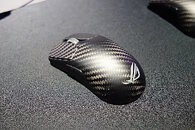
ASUS ROG Harpe Ace Mini
As far as materials go, the Mini closely matches the regular Harpe Ace, as the shell once again is made out of bio-based nylon. The surface treatment, however, differs greatly, as the Harpe Ace Mini features a much smoother matte coating as opposed to the rougher, more textured surface of the regular Harpe Ace. In terms of shape, the Mini closely matches the regular Harpe Ace, including the hump position and curvature, and only some minor details differ. At 49 g, it weighs less than the regular Harpe Ace by the amount one would expect in proportion to the difference in size. Of note is once again how solid the demonstration unit felt, as there was no shell creaking or flexing, and all buttons had pleasantly low travel. Though the Mini is compatible with the ROG Polling Rate Booster, that has to be purchased separately. At 1000 Hz, ASUS cited a click latency of 0.842 ms on average, and 105 hours of battery life.
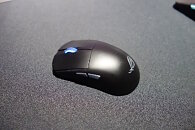
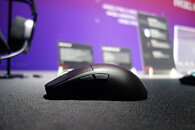
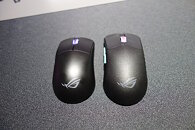
ROG Falchion Ace HFX, ROG Pelta, and partnership with Max "Demon1" Mazanov
Among the most requested features for ASUS keyboards has been rapid trigger functionality, and with the 65% analog ROG Falchion Ace HFX, ASUS finally delivers this much sought after feature. Of note is that it can be easily enabled or disabled by a simple knob at the top of the keyboard without requiring software. In addition, a feature typically known under the name SOCD (short for Simultaneous Opposing Cardinal Directions) will also be present, but given how it already has been banned by Valve in Counter-Strike 2, this feature will be disabled by default and require a specific button combination to enable. ASUS cites a wired button latency of 1.1 ms on average at a polling rate of 8000 Hz, rendering the ROG Falchion Ace HFX one of the most responsive keyboards currently available. ROG HFX magnetic switches are used, whose initial force sits at 4.0 gf, and whose actuation range can be configured from 0.1 to 4.0 mm.
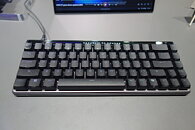
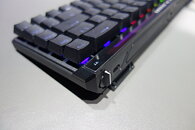
The ROG Pelta is a gaming headset, and its most notable feature is the fact that it rather closely tracks the Harman curve, which is typically regarded as the most generally preferred frequency response curve. Up to 60 hours of battery life are cited without RGB lighting in 2.4 GHz wireless operation, and potentially even more using Bluetooth.
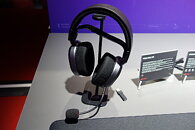
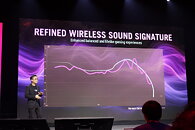
Lastly, professional FPS player Max "Demon1" Mazanov, who is the winner of VALORANT Champions 2023, has been announced as the new ambassador of ROG gaming gear, has already given his input on the releases featured above, and will continue to give feedback to further improve future ROG peripheral releases.

View at TechPowerUp Main Site | Source
Shared between both mice are their basic specifications and internals. Much like on the ROG Keris II Ace, ASUS's latest AimPoint Pro sensor capable of 42,000 CPI sees use, along with ROG Optical main button switches. When asked for comment, ASUS has stated that on their enthusiast mouse releases, optical switches will continue to be preferred over push-fit mechanical switch sockets to save as much weight as possible. Through the ROG Polling Rate Booster, polling rates of up to 8000 Hz can be achieved in wired operation, and up to 4000 Hz in wireless operation. Since the firmware is shared across all models, performance of the ROG Harpe Ace Mini and the Harpe Ace Extreme will closely match the Keris II Ace provided the ROG Polling Rate Booster is used.




Those generally interested in ASUS mice but scared off by the prospect of having to deal with Armoury Crate will be pleased to hear that by the end of 2024, Armoury Crate will be reworked to become modular. In other words, one will be able to only install the parts actually desired, reducing both the installation size and RAM footprint in the process. In a way, it will be possible to tailor one's own Armoury Crate Gear.
ASUS ROG Harpe Ace Extreme
At 47 g, the Extreme weighs 7 g less than the regular Harpe Ace, which, depending on how one looks at it, could be considered a success or a disappointment. In any case, one has to keep in mind that the shell typically only accounts for roughly a third of the total weight, which is why the ability to save weight in this area is limited, and ASUS has valued structural integrity over achieving the lowest possible weight. Whereas the shell of the regular Harpe Ace has been made of bio-based nylon, the Extreme comes with a fully CNC-machined carbon fiber shell. No comment has been made which modulus is used, and the numbers provided by ASUS are inconclusive in this regard, too. Regardless of modulus, carbon fiber will surpass any other material used in gaming mice thus far in terms of stiffness-to-weight ratio and, more specifically, its tensile strength. On the other hand, carbon fiber tends to be more brittle than other materials used in gaming mice, leading to poorer shock absorption. Another key property of carbon fiber is the fact that it tends to be somewhat dusty, though the demonstration unit at least appeared well-kept in this regard, and a cleaning kit is included with the mouse. In general, the mechanical design on the Extreme is on a high level, exhibiting limited lateral main button movement, tight tolerances, and low button travel across the board. Though the regular Harpe Ace with the ROG Polling Rate Booster would be a near-match in terms of performance, the Extreme sure trumps it as a vanity object, which is why a display stand being included with the box is par for the course.

ASUS ROG Harpe Ace Mini
As far as materials go, the Mini closely matches the regular Harpe Ace, as the shell once again is made out of bio-based nylon. The surface treatment, however, differs greatly, as the Harpe Ace Mini features a much smoother matte coating as opposed to the rougher, more textured surface of the regular Harpe Ace. In terms of shape, the Mini closely matches the regular Harpe Ace, including the hump position and curvature, and only some minor details differ. At 49 g, it weighs less than the regular Harpe Ace by the amount one would expect in proportion to the difference in size. Of note is once again how solid the demonstration unit felt, as there was no shell creaking or flexing, and all buttons had pleasantly low travel. Though the Mini is compatible with the ROG Polling Rate Booster, that has to be purchased separately. At 1000 Hz, ASUS cited a click latency of 0.842 ms on average, and 105 hours of battery life.



ROG Falchion Ace HFX, ROG Pelta, and partnership with Max "Demon1" Mazanov
Among the most requested features for ASUS keyboards has been rapid trigger functionality, and with the 65% analog ROG Falchion Ace HFX, ASUS finally delivers this much sought after feature. Of note is that it can be easily enabled or disabled by a simple knob at the top of the keyboard without requiring software. In addition, a feature typically known under the name SOCD (short for Simultaneous Opposing Cardinal Directions) will also be present, but given how it already has been banned by Valve in Counter-Strike 2, this feature will be disabled by default and require a specific button combination to enable. ASUS cites a wired button latency of 1.1 ms on average at a polling rate of 8000 Hz, rendering the ROG Falchion Ace HFX one of the most responsive keyboards currently available. ROG HFX magnetic switches are used, whose initial force sits at 4.0 gf, and whose actuation range can be configured from 0.1 to 4.0 mm.


The ROG Pelta is a gaming headset, and its most notable feature is the fact that it rather closely tracks the Harman curve, which is typically regarded as the most generally preferred frequency response curve. Up to 60 hours of battery life are cited without RGB lighting in 2.4 GHz wireless operation, and potentially even more using Bluetooth.


Lastly, professional FPS player Max "Demon1" Mazanov, who is the winner of VALORANT Champions 2023, has been announced as the new ambassador of ROG gaming gear, has already given his input on the releases featured above, and will continue to give feedback to further improve future ROG peripheral releases.

View at TechPowerUp Main Site | Source






